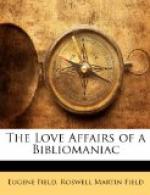Sir Walter Scott was similarly careful with his books, and he used, for purposes of dusting them, the end of a fox’s tail set in a handle of silver. Scott, was, however, particular and systematic in the arrangement of his books, and his work-room, with its choice bric-a-brac and its interesting collection of pictures and framed letters, was a veritable paradise to the visiting book-lover and curio-lover. He was as fond of early rising as Francis Jeffrey was averse to it, and both these eminent men were strongly attached to animal pets. Jeffrey particularly affected an aged and garrulous parrot and an equally disreputable little dog. Scott was so stanch a friend of dogs that wherever he went he was accompanied by one or two—sometimes by a whole kennel—of these faithful brutes.
In Mrs. Gordon’s noble ``Memoirs’’ we have a vivid picture of Professor Wilson’s workroom. All was confusion there: ``his room was a strange mixture of what may be called order and untidiness, for there was not a scrap of paper or a book that his hand could not light upon in a moment, while to the casual eye, in search of discovery, it would appear chaos.’’ Wilson had no love for fine furniture, and he seems to have crowded his books together without regard to any system of classification. He had a habit of mixing his books around with fishing-tackle, and his charming biographer tells us it was no uncommon thing to find the ``Wealth of Nations,’’ ``Boxiana,’’ the ``Faerie Queen,’’ Jeremy Taylor, and Ben Jonson occupying close quarters with fishing-rods, boxing-gloves, and tins of barley-sugar.
Charles Lamb’s favorite workshop was in an attic; upon the walls of this room he and his sister pasted old prints and gay pictures, and this resulted in giving the place a cheery aspect. Lamb loved old books, old friends, old times; ``he evades the present, he works at the future, and his affections revert to and settle on the past,’’—so says Hazlitt. His favorite books seem to have been Bunyan’s ``Holy War,’’ Browne’s ``Urn-Burial,’’ Burton’s ``Anatomy of Melancholy,’’ Fuller’s ``Worthies,’’ and Taylor’s ``Holy Living and Dying.’’ Thomas Westwood tells us that there were few modern volumes in his library, it being his custom to give away and throw away (as the same writer asserts) presentation copies of contemporaneous literature. Says Barry Cornwall: ``Lamb’s pleasures lay amongst the books of the old English writers,’’ and Lamb himself uttered these memorable words: ``I cannot sit and think—books think for me.’’
Wordsworth, on the other hand, cared little for books; his library was a small one, embracing hardly more than five hundred volumes. He drew his inspiration not from books, but from Nature. From all that I have heard of him I judge him to have been a very dull man. Allibone relates of him that he once remarked that he did not consider himself a witty poet. ``Indeed,’’ quoth he, ``I don’t think I ever was witty but once in my life.’’




